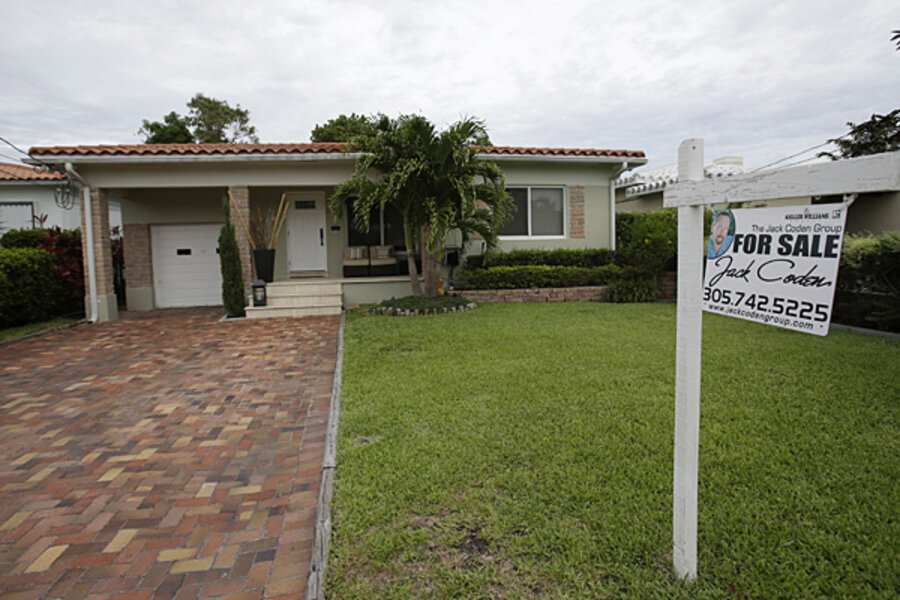Housing alert: Flippers are back
Loading...
For Michael LaCava, the shift happened, quite suddenly, at the start of 2013:
"It's like someone hit a switch. All of a sudden the market just heated up," says Mr. LaCava, a real estate investor in southeastern Massachusetts who flips houses (i.e., buys them, fixes them up, and sells them at a higher price). "It went from a buyer's market to where I'll have just finished a house, and we get five offers the first day on the market. We're getting demands before we're even listing right now, and that's happening all over."
The change was similar for Matt Manner:
"I just sold a house that had 83 offers on it and went for $532,000 cash," says the owner of Extraordinary Real Estate, who flips houses in northern Los Angeles. "I'm seeing a 50 percent increase in profit from the properties we bought last year and are finishing this year. If we bought now, it would be a regular-type profit," somewhere between 20 and 30 percent.
In the midst of the housing recovery, flipping is making a comeback, too. In 2012, many of the metro areas hit hardest by the bust turned huge profits for flippers as house prices rebounded. In Phoenix, for example, a single-family flip brought in 44 percent average gross profit last year (that is, before expenses of the refurbishment are factored in). In Las Vegas, the gross profit margin for flippers was 53 percent, on average.
The gains are widespread, but two market types are particularly fertile ground for flippers, says Daren Blomquist, vice president of RealtyTrac, an online foreclosure listings site based in Irvine, Calif. "Markets with the fastest home price appreciation, like L.A., Miami, and Phoenix. That's one correlation," he says.
The other is cities with high foreclosure rates. Distressed bank-owned homes are a prime target for flippers, who can often buy them for cash at auction and add significant value.
This time around, the industry will look far different from the fad market that cropped up during the housing bubble. For one, Mr. Blomquist points out, the tighter restrictions of today's housing market mean the flip game is more limited, by factors including tighter lending standards and available houses in relatively deeper disrepair. "Your profile is your seasoned real estate investor who survived the downturn, and now is able to come back in and have the resources to buy these properties, mostly with cash," he says.
In the early 2000s, because of loose lending standards and rapid price appreciation, there was "lots of opportunity to get in the game," says Paul Mydelski, a broker with RE/MAX Leading Edge, based in eastern Massachusetts. "Now it requires someone with their nose to the ground. What we used to see was lousy contractors making a buck, but I think there's less of that."
"You had very novice flippers coming in and buying the properties quite easily. And they just relied on home price appreciation. That's still helping, but the flippers now really need to add value to get them sold," Blomquist adds.
Another difference: During the bubble, flippers were working in a market already saturated with available homes as the result of a construction boom. Post-bubble, flippers could be a big help in easing some of the recovery's growing pains. In certain cities, they could help reduce the backlog of foreclosures, which can be scary propositions for regular home buyers.
"A lot of buyers would be turned off by the work needed to get these properties into livable condition," Blomquist says. "And there's the fact that buying a foreclosure can be a more complex transaction with a bank. The flippers are willing to take that on."
They can also add more salable homes to areas with tight inventory. Construction spending is growing slowly, limiting the number of new homes available to sell. Flippers can help fill in some of the gap until construction starts keeping pace with buyer demand. "It was less necessary before, because you had a building boom at the same time and an oversupply," Blomquist notes. "You don't have that yet."
Some of those big profits in recovering markets should shrink as the market stabilizes, experts warn. A 50 percent net gain is far from normal. But Mr. Mydelski thinks there will still be a market niche for flippers.
"Most homeowners, before 2005, they were willing to do some [renovation] work," he says. "But people now have less time, and they want to buy things complete. If investors can get these projects, there is money to be made."






